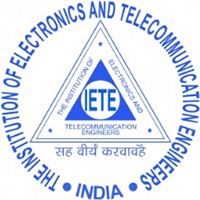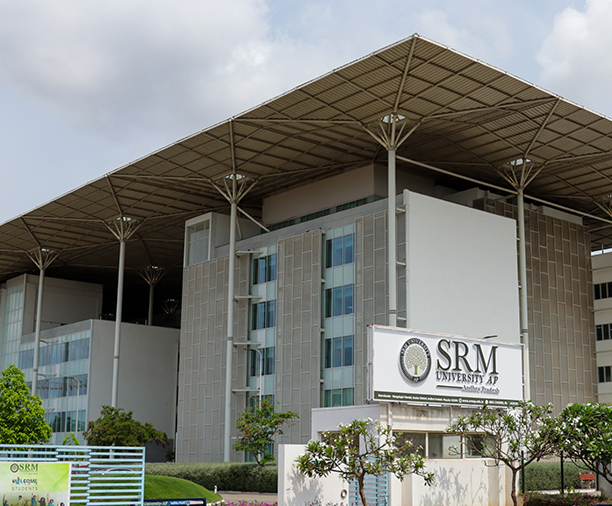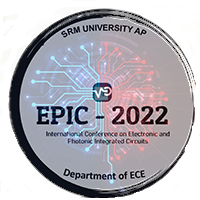POST-DEADLINE PAPER SUBMISSION
Post-deadline submissions are encouraged to provide late-breaking research for showcasing (till 10th December 2022)

International Conference on Electronic and Photonic Integrated Circuits
for Applications to: AI & ML, Quantum Communication, Healthcare, MOEMS, RF & THz

Last date for submission of abstracts: November 20, 2022
Please prepare the abstract using the given template and upload the file during registration.
The abstract will be peer-reviewed and accepted as oral/poster for EPIC2022. Selected full papers will be published in Scopus indexed journal
Further questions related to abstract submission and the scientific program can be sent to conf.epic@srmap.edu.in
• Wide bandgap semiconductors
• Bio-inspired electronic materials
• Sustainable electronic materials
• Functional Materials
• Emerging Advanced Electronic Materials
• Hybrid Electronic Materials
• Computational materials science
• Mathematical models and numerical models
• Calibration and validation of models and material parameters
• Flexible and Organic Electronics
• Mechanical behavior of materials
• Quantum dots
• Nanotubes
• Dielectric and magnetic materials
• Nanostructured material and device
• Nanoparticle and Nanocomposites
• Materials System
• Silicon wafer-based Electronics
• Flexible sensors for healthcare and robotics (artificial skin)
• Solar cells & Flexible solar cells
• Electronic Display devices
• Electronic Sensors
• Next-Generation Semiconductors and Materials
• Next-Generation energy materials
• Innovative Electronic Materials Processing Technologies
• Medical Electronics
• Novel Architectures and Functional Blocks of Electronic Materials
• Wearable Electronic Devices and Models
• Characterization of Electronic Materials
• Luminescent and Non-Luminescent Materials
• Novel Synthesis Techniques
• Novel Electronic Material Fabrication
• Electronic Packaging Techniques
• Electronic Modelling and Simulation
• Noise modeling and simulation
• Electronic Material Standardization and Synthesis
• Rechargeable batteries
• Active and Passive photonic elements
• Si, SOI, SiN, Compound semiconductors, polymers, lithium niobate
• Advanced Optical materials
• Modulators
• Photodetectors
• Optical Amplifiers
• Optical fiber sensors
• Waveguide devices
• Whispering gallery mode resonators
• Micro-ring resonators
• Photonic crystals
• Gratings
• Nanocavities
• Nanowires
• Nanotubes
• Devices for coupling light to 2D materials
• Optical/Photonic sensors and sensing technologies
• Physics and theory of photonic nanostructures
• Fabrication and characterization of photonic Nanostructures and devices
• Fiber Optics
• Photonic circuits
• Photonic links including high speed devices
• Mathematical models and numerical models
• Calibration and validation of models and material parameters
• Noise modeling and simulation
• Ultrafast Photonics
• Characterization of optical properties of materials
• Optical design
• Optical alignment and Testing
• 3-D printed optics
• Photonic Integration
• Biophotonics
• Neurons and Networks with Photonic circuits
• Semiconductor LASERS and LEDs
• Optoelectronic integrated circuits
• Novel materials, devices, and simulation tools
• Design and Optimization of optoelectronic devices
• Analysis of device performance and internal processes
• Electron-photon interaction and Plasmonics
• Physics and theory of optoelectronic nanostructures
• Optoelectronic Material properties
• Meta-material properties
• Organic materials and devices
• Fabrication process theory and simulation
• Packaging and Integration issues
• Mathematical models and numerical models
• Calibration and validation of models and material parameters
• Audio and Acoustic Signal Processing
• Speech Processing
• Natural language processing
• Graph Theory and Signal Processing
• Quantum Signal Processing
• Remote Sensing and Signal Processing
• Biomedical Signal and Image Processing
• Compressive Sensing, Sampling, and Dictionary Learning
• Sensor Array & Multichannel Signal Processing
• Signal Processing for Communication and Networking
• Image, Video and Multidimensional
• Signal Processing for Cyber Security
• Industrial Signal Processing
• Signal Processing for Education
• Information Forensics and Security
• Signal Processing for Smart Systems
• Machine learning in signal processing
• Next generation Ad-hoc, Mobile and Sensor Networks
• Seamless heterogeneous wireless networks
• Satellite and Space Communications
• 5G/6G Wireless Technologies
• MIMO, Massive MIMO, mm-Wave MIMO
• Software-Defined Networking (SDN)
• Green and energy efficient wireless networks
• Smart Antennas
• IoT enabling technologies
• Industrial Internet of Things
• Web of Things
• Fog/Edge Computing to IoT
• IoT Security and Block Chain for IOT
• Data analytics for IOT
• IOT for Health care
• IOT Communication protocols
• 4G/5G wireless communications
• System-on-chip design (ASIC and FPGA)
• Electronic System Level (ESL) design and verification
• System-level design methodology
• Processor and memory design, Concurrent interconnect
• Networks-on-chip,
• Defect Tolerant Architectures, Hardware/Software Co-Design & Verification
• Reconfigurable computing
• Embedded Multicores SOC and Systems
• Embedded Software Including Operating Systems, Firmware, Middleware, Communication, Virtualization, Encryption, Compression, Security, Reliability
• Hybrid systems-on-chip, Embedded for automotive and Electric Vehicles
• Real Time Systems
• Networked Embedded Systems
• Embedded System Security
• Design of IoT Devices/Networks
• Embedded Edge Computing
• Embedded Machine Vision for UAV
• Multi Core Embedded Systems
• Embedded Machine Learning
• Automotive Embedded Systems
• Augmented Reality
• Virtual Reality
• Image Processing
• Medical Diagnosis
• Human Computer Interaction
• Reinforcement Learning.
• Robotics
• Natural Language Processing
• Computer Vision
• Expert Systems.
• Social Network Analysis
• Application of AI/ML to agriculture
• Application of AI/ML to power generation
• Photolithography
• Soft lithography
• Film deposition
• Etching
• Bonding
• Molecular self-assembly
• Electrically induced nanopatterning
• Rapid prototyping
• Electron, X-ray, colloidal monolayer
• Focused ion beam lithography
• Electron beam lithography
• Two photon polymerizations
• Challenges of micro and nano fabrication technology: laboratory and industry scale
• MEMS & NEMS
• Neuromorphic computing systems: device, circuit, architecture design, analysis, and optimization
• Complexity and scalability of neuromorphic computing
• Emerging technologies for brain-inspired nanocomputing and communication
• Applications of neuromorphic computing in embedded and IoT devices, unmanned vehicles and drones, cyber-physical systems
• Essence of Quantum Physics
• Theoretical and mathematical foundations of Quantum information theory
• Quantum codes
• Quantum entanglement
• Software techniques for error correction and noise mitigation
• Quantum Superposition & Interference phenomenon
• Thermodynamics of Quantum Computation
• Quantum computing architecture and micro-architecture
• Qubit technologies: ion trap, superconducting, quantum dots, silicon, photonics, quantum annealers, and others
• Quantum linear algebra
• Quantum Machine Learning (QML), encoding and learning algorithms
• Quantum simulation of physical systems
• Sources
• Detectors
• Transmission
• electronic considerations and applications
• optical (photonic) considerations and applications
• RTDs
• HEMTs
• Modeling & Simulation
• System Biology
• Smart healthcare
• Low-cost design for quality healthcare delivery
• Machine learning and Deep Learning in therapeutic and diagnostic applications
• Biomaterials and artificial organs
• Clinical engineering
• Block chain applications in healthcare
• IOT in healthcare
• Critical care solutions for COVID-19
• Biomedical Signal and Image Processing
• POCHT
• Biosensor Design and Development
• Computer aided visualization tools
- Papers should represent novel research contribution and should be written in English.
- All papers must be in pdf format and with saveable text.
- Each paper is to be written in double-column IEEE format and must not exceed 6-pages (including abstract, figures, tables, and references)
- Please indicate the most relevant track for your abstract as mentioned in the conference Call for Papers.
- Your submission must not include information that serves to identify the authors of the manuscript, such as name(s) or affiliation(s) of the author(s), anywhere in the manuscript, abstract, or in the embedded pdf data. References and bibliographic citations to the author’s own published work or affiliation should be made in the third person.
- Submissions not adhering to the above-mentioned rules, or determined to be previously published, or simultaneously submitted to another conference or journal will be summarily rejected.
- Technical Programme Chairs reserve the right to finally reject any manuscript not adhering the rules

